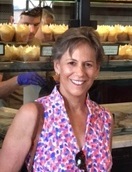

My name is Diane Sarver and I am 67 years old. I am a mom, a wife, a friend, a sister, and for the last seven years, a four-time survivor of ovarian cancer.
The presentation of my ovarian cancer was very unusual — I had no pelvic symptoms at all and I was in great health. However, a little pocket of fluid in my left neck was noticed by a very sharp physical therapist. This led to a neck CT which was negative. I kept feeling the pocket and about six months later noticed a very small lump, so an ENT did a fine needle aspirate on the fluid. The report noted cells suspicious for adenocarcinoma.
In rapid succession, I saw a hem/oncologist for a full body PET scan which showed no nodes in my chest and neck but no pelvic involvement either. A head and neck trauma surgeon performed a biopsy on the neck tissue. Many fancy molecular tests including FISH and flow cytometry were done on the tissue, and with these, a chest MRI, and finally a CA 125 blood test. At that time, the ovarian cancer diagnosis was made.
I am a clinical technologist specializing in hematology, which can at times be a good or not so good bit of background. It was the hematopathologist who delivered the diagnosis in January 2010. I was quickly referred to a gynecologic oncologist who performed the debulking surgery with partial omentum removal. Pathology on these tissues showed a small dot on the left ovary as the primary. Seeing a gynecologic oncologist is the key here because this subspecialty skillfully performs surgery and also manages all the therapeutic needs of patients throughout the course of disease. They are the most important partner in seeking health, and survival outcomes and disease-free progression are best when in their care.
I did switch to a second gynecologic oncologist. The first one who performed the debulking was an excellent surgeon and I had felt safe with his skills, but his bedside manner did not fit my needs. I asked a nurse navigator for suggestions for a new gyn onc. This was perhaps my best move, because trust in the clinician is necessary for wellness.
Telling my children and husband about my diagnosis was the most difficult, and I just could not gear up to tell friends. My kids were 14 and 16 at the time. I told them they should know three things: that I am the strongest person in our family, that I have the very best medical care, and that my faith would help see me through (eye roll from my daughter). I decided to have the BRCA genetic testing done; my results were negative and I could tell my daughter that the tests were negative and that she has no more risk than the rest of the population for ovarian cancer, about 0.8%.
Early on I saw a therapist for some coping skills because I felt so ill-equipped to handle all that was coming to me. One of the tricks was visualization and here is where decades of looking through a microscope was useful — I could easily picture T cells, B cells, NKs and macrophages. I also tried to adopt the saying, “If IT isn’t happening today, IT isn’t happening,” –the meaning of which is that worry serves no one.
After a post-op month long bout of C. difficile, I began the standard of care carboplatin/taxol for six cycles. This produced a rapid drop in my CA 125 number and tumor burden, and allowed a two and one-half year remission.
Although I always felt great and never missed a day of work or life, the CA 125 began to rise and I started another induction type treatment of carbo/taxol for six cycles. This brought a quick normalization of CA 125 and a remission for another one and one-half years.
Then came a second relapse noted by a rising CA 125, and treatment with Doxil for six cycles resulting in another remission for about a year. Over several years, I had 17 cycles of chemo, been bald twice, and lost the skin on the soles of my feet. But, I always felt grateful because, in my case, the cancer is retroperitoneal and there were never any pelvic symptoms.
After successful treatment for initial diagnosis and two relapses within four years, I decided to be proactive and investigate other options. One of my friends knows an ovarian cancer researcher and clinician at MD Anderson in Houston whom I contacted and later visited. I learned of two clinical trials and decided to join a phase 1B study three years ago. This involves taking two synergistic oral drugs twice a day, a PARP inhibitor and an Mtor inhibitor. After about seven weeks on the trial my CA125 normalized, and fortunately I have had no side effects except for an occasional mouth sore. Because of this response and the absence of side effects I am called an “unusual responder.”
Earlier this year, my husband and I moved to Texas, and I am now closer to MD Anderson. As a new participant in the Survivors Teaching Students program, I have recently shared my cancer story with future medical students in my new home town.
